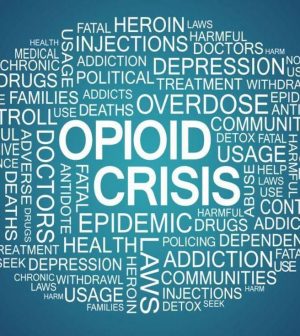- Navigating Your Midlife Crisis: Embracing New Possibilities
- City Raccoons Showing Signs of Domestication
- Mapping the Exposome: Science Broadens Focus to Environmental Disease Triggers
- One Week Less on Social Media Linked to Better Mental Health
- Your Brain Changes in Stages as You Age, Study Finds
- Some Suicide Victims Show No Typical Warning Signs, Study Finds
- ByHeart Formula Faces Lawsuits After Babies Sickened With Botulism
- Switch to Vegan Diet Could Cut Your Greenhouse Gas Emissions in Half
- Regular Bedtime Does Wonders for Blood Pressure
- Dining Alone Could Mean Worse Nutrition for Seniors
New CDC Guidelines May Have Made Opioid Prescribing Safer

Five years after the U.S. Centers for Disease Control and Prevention retooled a guideline for prescribing opioid painkillers, research suggests the change is paying off.
With the United States in the grip of an opioid overdose epidemic, the CDC released an evidence-based guideline in 2016 to help doctors treat patients’ pain while balancing the risks and benefits of prescription opioids.
“These findings, based on trends before and after the CDC guideline was released, show it may have catalyzed other changes, because it came from a trusted entity,” said study lead author Jason Goldstick. He is a research associate professor at the University of Michigan Medical School, in Ann Arbor.
“It’s impossible to isolate the effect of the guideline itself, given all the activity around opioid prescribing, but it’s important to track these trends and use them to inform future efforts to treat pain safely and effectively,” Goldstick said in a university news release.
For the study, his team analyzed data from 2011 to 2017 on between 4.5 million and 5.8 million people a year who had private insurance or a Medicare Advantage plan. None had filled an opioid prescription in the previous year.
The percentage of patients who filled an opioid prescription dropped from nearly 12% in the first year to just over 9% in the study’s final year.
The number of days’ supply in initial prescriptions was on the rise before the CDC guideline, even as the percentage of patients filling at least one prescription dropped.
After the guideline’s release, however, the duration of prescriptions dropped 5% in the first year and 10% in the second year, the study authors said.
The CDC guideline said clinicians treating acute pain should prescribe opioids at the lowest effective dose and for no longer than the pain was likely to last — three to seven days for most patients.
The study found a drop in the average days’ supply and the likelihood that initial prescriptions would call for doses larger than 50 MME (morphine milligram equivalents).
The investigators said any single change or trend can’t be attributed to the CDC’s guideline, but it may have played an important role in broader actions by prescribers.
The findings were published online recently in JAMA Network Open.
“Any progress toward safer prescribing is good,” Goldstick said. “There’s still progress to be made, and it could have a downstream effect on opioid use disorder, and overdose rates.”
More information
The U.S. National Institute on Drug Abuse has more about prescription opioids.
SOURCE: University of Michigan, news release, Aug. 12, 2021
Source: HealthDay
Copyright © 2025 HealthDay. All rights reserved.










